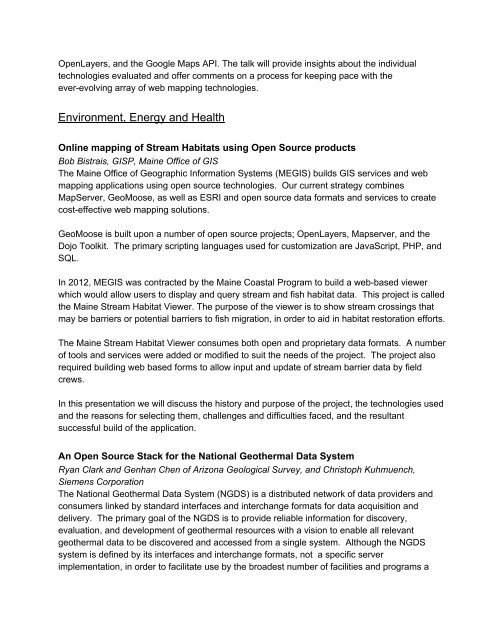FOSS4G North America Conference 2013 Preliminary Program
FOSS4G North America Conference 2013 Preliminary Program
FOSS4G North America Conference 2013 Preliminary Program
You also want an ePaper? Increase the reach of your titles
YUMPU automatically turns print PDFs into web optimized ePapers that Google loves.
OpenLayers, and the Google Maps API. The talk will provide insights about the individual<br />
technologies evaluated and offer comments on a process for keeping pace with the<br />
everevolving array of web mapping technologies.<br />
Environment, Energy and Health<br />
Online mapping of Stream Habitats using Open Source products<br />
Bob Bistrais, GISP, Maine Office of GIS<br />
The Maine Office of Geographic Information Systems (MEGIS) builds GIS services and web<br />
mapping applications using open source technologies. Our current strategy combines<br />
MapServer, GeoMoose, as well as ESRI and open source data formats and services to create<br />
costeffective web mapping solutions.<br />
GeoMoose is built upon a number of open source projects; OpenLayers, Mapserver, and the<br />
Dojo Toolkit. The primary scripting languages used for customization are JavaScript, PHP, and<br />
SQL.<br />
In 2012, MEGIS was contracted by the Maine Coastal <strong>Program</strong> to build a webbased viewer<br />
which would allow users to display and query stream and fish habitat data. This project is called<br />
the Maine Stream Habitat Viewer. The purpose of the viewer is to show stream crossings that<br />
may be barriers or potential barriers to fish migration, in order to aid in habitat restoration efforts.<br />
The Maine Stream Habitat Viewer consumes both open and proprietary data formats. A number<br />
of tools and services were added or modified to suit the needs of the project. The project also<br />
required building web based forms to allow input and update of stream barrier data by field<br />
crews.<br />
In this presentation we will discuss the history and purpose of the project, the technologies used<br />
and the reasons for selecting them, challenges and difficulties faced, and the resultant<br />
successful build of the application.<br />
An Open Source Stack for the National Geothermal Data System<br />
Ryan Clark and Genhan Chen of Arizona Geological Survey, and Christoph Kuhmuench,<br />
Siemens Corporation<br />
The National Geothermal Data System (NGDS) is a distributed network of data providers and<br />
consumers linked by standard interfaces and interchange formats for data acquisition and<br />
delivery. The primary goal of the NGDS is to provide reliable information for discovery,<br />
evaluation, and development of geothermal resources with a vision to enable all relevant<br />
geothermal data to be discovered and accessed from a single system. Although the NGDS<br />
system is defined by its interfaces and interchange formats, not a specific server<br />
implementation, in order to facilitate use by the broadest number of facilities and programs a


